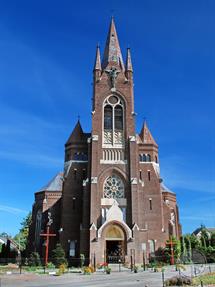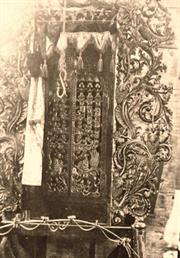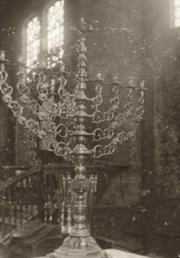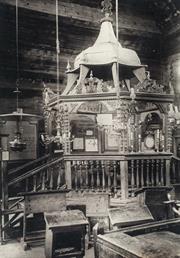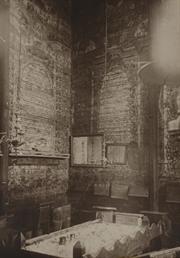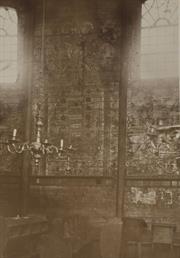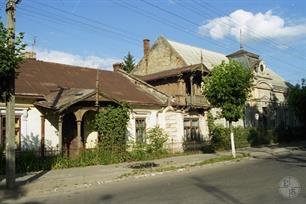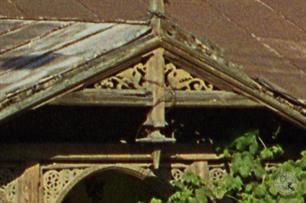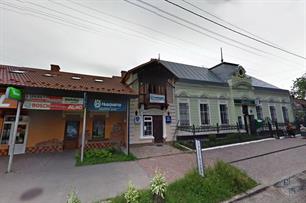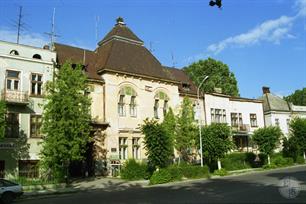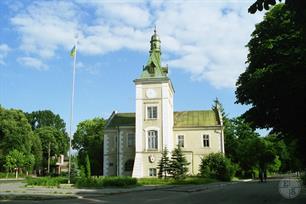Kamyanka-Buzka
Lviv district, Lviv region
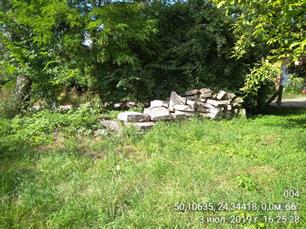 |
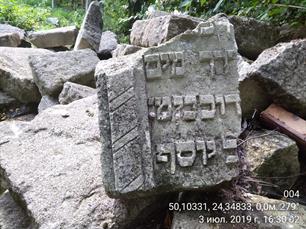 |
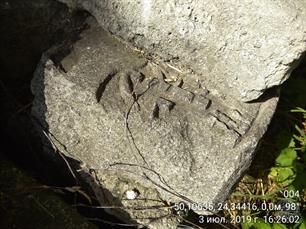 |
| Old Jewish cemetery in Kamianka Buzka, 2019 | ||
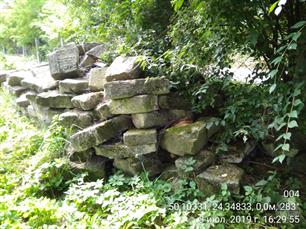 |
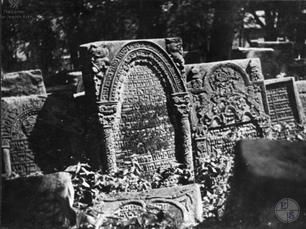 |
|
| Old Jewish cemetery in Kamianka-Buzka, 1928. Photo by Józef Awin |
Sources:
- Pinkas Hakehillot Polin: Encyclopedia of Jewish Communities, Poland, Volume II, published by Yad Vashem, Jerusalem. Translated by JewishGen, Inc.
Photo:
- J.Pinkerfeld, Jozef Awin, Boris Khaimovich. Published by Center for Jewish art
- Jewish Cemeteries Initiative. Kamyanka-Buzka Old Jewish Cemetery
- Pinkas Hakehillot Polin: Encyclopedia of Jewish Communities, Poland, Volume II, published by Yad Vashem, Jerusalem. Translated by JewishGen, Inc.
Photo:
- J.Pinkerfeld, Jozef Awin, Boris Khaimovich. Published by Center for Jewish art
- Jewish Cemeteries Initiative. Kamyanka-Buzka Old Jewish Cemetery
Year - Total Population - Jews
1765 - (?) - 522
1880 - 6,107 - 2,922
1890 - 6,483 - 3,142
1900 - 7,310 - 3,164
1910 - 8,106 - 3,549
1921 - 6,518 - 2,685
1931 - (?) - 3,283
1765 - (?) - 522
1880 - 6,107 - 2,922
1890 - 6,483 - 3,142
1900 - 7,310 - 3,164
1910 - 8,106 - 3,549
1921 - 6,518 - 2,685
1931 - (?) - 3,283
Kamyanka-Buzka (ukr. Кам'янка-Бузька) was previously known as Kamionka–Strumilowa and was a district city in Galicia. From 1918 to 1939 it was part of Poland, and called Kamionka–Strumilowa. It is 40 km (25 miles) to the northeast of Lemberg–Lwow–Lviv. The whole area is situated in the Vistula River basin, on the Bug River.
Kamionka is first mentioned as a village in 1448. Then its status changed to that of a city. In 1509, taxes were imposed on the trade of wine, and the money was used to build fortifications in the city. Later on, taxes were imposed on the salt merchants salt who had to remain in the hamlet for three days.
In the 16th century, the city saw the formation of “guilds” or artisan associations. Fishing was an important source of income as the hamlet was situated on the River Bug that provided a means of transportation all the way to the port of Danzig.
In the 19th century there were flour mills, carpentries using steam engines, a brewery, a textile plant and a brick factory in Kamionka–Strumilowa.
Kamionka is first mentioned as a village in 1448. Then its status changed to that of a city. In 1509, taxes were imposed on the trade of wine, and the money was used to build fortifications in the city. Later on, taxes were imposed on the salt merchants salt who had to remain in the hamlet for three days.
In the 16th century, the city saw the formation of “guilds” or artisan associations. Fishing was an important source of income as the hamlet was situated on the River Bug that provided a means of transportation all the way to the port of Danzig.
In the 19th century there were flour mills, carpentries using steam engines, a brewery, a textile plant and a brick factory in Kamionka–Strumilowa.
The first Jews appeared in Kamionka in about 1456, when two houses were owned by Jews.
In 1564, a head tax was imposed on 10 Jewish home owners.
In 1589, an understanding was reached between local Jews and the city leaders that Jews could build homes and conduct business without interference.
The Archbishop of Lemberg, Jan Pruchnik, gave the local Jews permission to build a synagogue in 1627.
The Jewish population grew during the 16th –18th centuries. They dealt in salt, trees, fish, wheat and cattle.
In 1765, 552 Jews lived in Kamionka.
In 1837, Sholom Rosenfeld (1800–1852) founded the Hasidic dynasty.
R. Sholom Rosenfeld wrote many chidushim on the Torah but preferred that they not be printed.
He died in his early fifties in 1851. Because this was a relatively young age for religious scholars in that time, he never served as a rebbe, although his contemporaries held him in great esteem.
His only son, Joshua (1830–1897), succeeded him as Rabbi of Kamianka-Buzka after his death.
In 1564, a head tax was imposed on 10 Jewish home owners.
In 1589, an understanding was reached between local Jews and the city leaders that Jews could build homes and conduct business without interference.
The Archbishop of Lemberg, Jan Pruchnik, gave the local Jews permission to build a synagogue in 1627.
The Jewish population grew during the 16th –18th centuries. They dealt in salt, trees, fish, wheat and cattle.
In 1765, 552 Jews lived in Kamionka.
In 1837, Sholom Rosenfeld (1800–1852) founded the Hasidic dynasty.
R. Sholom Rosenfeld wrote many chidushim on the Torah but preferred that they not be printed.
He died in his early fifties in 1851. Because this was a relatively young age for religious scholars in that time, he never served as a rebbe, although his contemporaries held him in great esteem.
His only son, Joshua (1830–1897), succeeded him as Rabbi of Kamianka-Buzka after his death.
Following the German attack on Poland on September 1, 1939, hundreds of Jews fled to the eastern part of Poland. Kamionka received many Jews from Western Poland. The Jewish population now grew to about 4,000 residents. The local Jewish population organized itself to help absorb the Polish Jewish refugees.
On September 17, 1939, the Soviet Union attacked Poland, which was fighting the Germans. Poland collapsed and the Soviet army soon entered Kamionka–Strumilowa.
According to Israel Pasternak, a native of Kamionka, “the Soviet army entered the city followed by the Soviet secret police and the Communist Party. A local branch of the party was immediately opened in Kamionka and people were urged to join. The leadership of the city was being replaced by party members. Some of the dismissed people were arrested by the local secret police known as the N.K.V.D. All local residents were immediately converted to Soviet citizens.
The Polish refugees were also urged to become Soviet citizens. All Zionist and Jewish national organizations were closed. Only the party newspaper appeared. Large places of employment were nationalized as were the banks. People began to watch themselves, as individuals were taken away at night and disappeared. Everybody was urged to get a job. Shortages of necessities became a daily occurrence.
Artisans organized cooperatives. Slowly private stores went out of business because they could not replace their merchandise. Coupons were introduced for everything from bread to shoes. Pasternak started to work for the government but the pay was small and barely covered his expenses. Then one day, all refugees who refused to become Soviet citizens were rounded up and deported to the interior of the Soviet Union, mainly to Siberia. Within a short period of time, the Jewish population was economically pauperized”.
Germany then attacked the Soviet Union and made great military strides. The Soviet army began to retreat and a few young Jews from Kamionka–Strumilowa joined the retreating forces, among them Israel Pasternak. He left his family and began to retreat to the depths of the Soviet Union.
The Germans occupied the city on June 28, 1941, and the next day they detained and murdered 200 Jews. July 2,1941, the local population staged an anti–Jewish pogrom with the encouragement of the Germans. The same month the Germans established the Judenrat, a Jewish council that would comply with all Gestapo requests, including cheap labor. German actions continued and a labor camp was established in the city. Jews from the nearby small villages were driven to the Kamionka–Strumilowa camp.
On September 15, 1942, the big selection took place and 1,500 Jews were sent to the Belzec death camp. A few days later, 600 Jews were murdered in the vicinity of the city during another German action. Peshe Rozen, a resident of Kamionka–Strumilowa, described what happened: “The Germans went from house to house, farm to farm looking for Jews. I was hidden in a tool shed and survived the mass hunt. Within a day, I left Kamionka–Strumilowa and headed to the ghetto of Jarczow where my family was living. My husband and daughter were grabbed by the Germans and sent to Belzec”.
Following these German actions, the surviving Jews began to look for hiding places and built shelters to hide in. The Germans continued to hunt for Jews and managed to round up another few hundred that were sent to Belzec.
A few Jews remained in the city that worked for the German army and some cleaning details. They too were gradually murdered. Some Jews managed to escape and join the partisans. The city was liberated by the Soviet army on July 27, 1944.
The city had a few Jewish survivors. Some like Peshe returned from a German labor camp in the hope of finding relatives. Then Jews began to return from the depths of the Soviet Union, among them Israel Pasternak who was very ill. She tended to him, they married and remained in Kamionka–Strumilowa.
There were a few other elderly Jews in the city but most Jewish survivors left the city. Israel Pasternak and his wife Peshe Rozen–Pasternak left Kamionka–Strumilowa in 1957 for Israel.
On September 17, 1939, the Soviet Union attacked Poland, which was fighting the Germans. Poland collapsed and the Soviet army soon entered Kamionka–Strumilowa.
According to Israel Pasternak, a native of Kamionka, “the Soviet army entered the city followed by the Soviet secret police and the Communist Party. A local branch of the party was immediately opened in Kamionka and people were urged to join. The leadership of the city was being replaced by party members. Some of the dismissed people were arrested by the local secret police known as the N.K.V.D. All local residents were immediately converted to Soviet citizens.
The Polish refugees were also urged to become Soviet citizens. All Zionist and Jewish national organizations were closed. Only the party newspaper appeared. Large places of employment were nationalized as were the banks. People began to watch themselves, as individuals were taken away at night and disappeared. Everybody was urged to get a job. Shortages of necessities became a daily occurrence.
Artisans organized cooperatives. Slowly private stores went out of business because they could not replace their merchandise. Coupons were introduced for everything from bread to shoes. Pasternak started to work for the government but the pay was small and barely covered his expenses. Then one day, all refugees who refused to become Soviet citizens were rounded up and deported to the interior of the Soviet Union, mainly to Siberia. Within a short period of time, the Jewish population was economically pauperized”.
Germany then attacked the Soviet Union and made great military strides. The Soviet army began to retreat and a few young Jews from Kamionka–Strumilowa joined the retreating forces, among them Israel Pasternak. He left his family and began to retreat to the depths of the Soviet Union.
The Germans occupied the city on June 28, 1941, and the next day they detained and murdered 200 Jews. July 2,1941, the local population staged an anti–Jewish pogrom with the encouragement of the Germans. The same month the Germans established the Judenrat, a Jewish council that would comply with all Gestapo requests, including cheap labor. German actions continued and a labor camp was established in the city. Jews from the nearby small villages were driven to the Kamionka–Strumilowa camp.
On September 15, 1942, the big selection took place and 1,500 Jews were sent to the Belzec death camp. A few days later, 600 Jews were murdered in the vicinity of the city during another German action. Peshe Rozen, a resident of Kamionka–Strumilowa, described what happened: “The Germans went from house to house, farm to farm looking for Jews. I was hidden in a tool shed and survived the mass hunt. Within a day, I left Kamionka–Strumilowa and headed to the ghetto of Jarczow where my family was living. My husband and daughter were grabbed by the Germans and sent to Belzec”.
Following these German actions, the surviving Jews began to look for hiding places and built shelters to hide in. The Germans continued to hunt for Jews and managed to round up another few hundred that were sent to Belzec.
A few Jews remained in the city that worked for the German army and some cleaning details. They too were gradually murdered. Some Jews managed to escape and join the partisans. The city was liberated by the Soviet army on July 27, 1944.
The city had a few Jewish survivors. Some like Peshe returned from a German labor camp in the hope of finding relatives. Then Jews began to return from the depths of the Soviet Union, among them Israel Pasternak who was very ill. She tended to him, they married and remained in Kamionka–Strumilowa.
There were a few other elderly Jews in the city but most Jewish survivors left the city. Israel Pasternak and his wife Peshe Rozen–Pasternak left Kamionka–Strumilowa in 1957 for Israel.
In the late 19th – early 20th century, the Jewish population was constantly growing from 2,922 (47.8% of the total population) in 1880 to 3,549 (43.8% of the total population) in 1910.
In 1913, a big fire swept the Jewish quarter in Kamionka and most of the Jewish homes were destroyed.
Soon World War One started and most Jews left the city for fear of the advancing Russian forces known for their anti–Jewish behavior.
Following the war, many Kamionka Jews did not return to the city.
Following World War One, the Jewish workers were slowly forced out of the local work force and had no choice but to turn to small commerce: peddling, trade or artisanship.
The Jewish economic situation declined rapidly. Poverty forced more and more Jews to seek social help from the Jewish population in Kamionka. Several small banks were opened to help the Jewish economic sector.
The high rate of unemployment also brought social changes among the Jewish population.
In 1921, it numbered 2,685 (41.2% of the total population).
Zionism appeared, especially among the Jewish youth. The Hashomer Ha–Tzair or Zionist Marxist youth movement opened a branch in the city in 1920, followed by the Poalei Tzion youth movement and the Ezra orthodox movement.
The Zionist adults challenged the local religious leaders for leadership of the community.
In 1927, there were four Jewish municipal counselors out of 16 members. One of the Jewish members was a Zionist.
In 1931, five Jews were elected to the municipal council, two Zionists, two religious Jews and one independent.
The Zionist supporters in Kamionka belonged to the General Zionists, Mizrahi and Labor.
There were also Jewish communists but little is known about them since the Communist Party was banned in Poland.
In 1931, the Jewish population increased to 3,283.
In 1913, a big fire swept the Jewish quarter in Kamionka and most of the Jewish homes were destroyed.
Soon World War One started and most Jews left the city for fear of the advancing Russian forces known for their anti–Jewish behavior.
Following the war, many Kamionka Jews did not return to the city.
Following World War One, the Jewish workers were slowly forced out of the local work force and had no choice but to turn to small commerce: peddling, trade or artisanship.
The Jewish economic situation declined rapidly. Poverty forced more and more Jews to seek social help from the Jewish population in Kamionka. Several small banks were opened to help the Jewish economic sector.
The high rate of unemployment also brought social changes among the Jewish population.
In 1921, it numbered 2,685 (41.2% of the total population).
Zionism appeared, especially among the Jewish youth. The Hashomer Ha–Tzair or Zionist Marxist youth movement opened a branch in the city in 1920, followed by the Poalei Tzion youth movement and the Ezra orthodox movement.
The Zionist adults challenged the local religious leaders for leadership of the community.
In 1927, there were four Jewish municipal counselors out of 16 members. One of the Jewish members was a Zionist.
In 1931, five Jews were elected to the municipal council, two Zionists, two religious Jews and one independent.
The Zionist supporters in Kamionka belonged to the General Zionists, Mizrahi and Labor.
There were also Jewish communists but little is known about them since the Communist Party was banned in Poland.
In 1931, the Jewish population increased to 3,283.
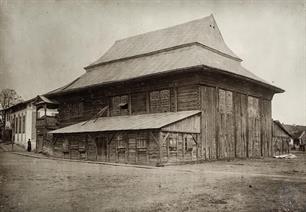 |
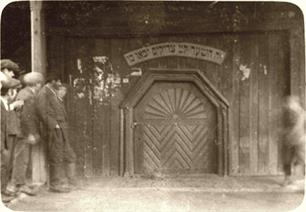 |
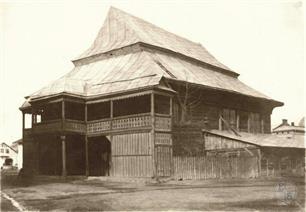 |
| Wooden Synagogue in Kamianka Buzka, 1900s. Photo by J.Pinkerfeld | "This is the gates of the Lord, the righteous will enter them" Teilim, 118:20 | In the foreground - Women's Gallery |

- Home
- Shtetls
- Vinnytsia region
- Volyn region
- Dnipro region
- Donetsk region
- Zhytomyr region
- Zakarpattia region
- Zaporizhzhia region
- Ivano-Frankivsk region
- Kyiv region
- Kropyvnytskyi region
- Luhansk region
- Lviv region
- Mykolayiv region
- Odessa region
- Poltava region
- Rivne region
- Sumy region
- Ternopil region
- Kharkiv region
- Kherson region
- Khmelnytskyi region
- Chernihiv region
- Chernivtsi region
- Cherkasy region
- Crimea
- Synagogues
- Cemeteries
- Objects & guides
- Old photos
- History
- Contact
Jewish towns of Ukraine
Jewish towns of Ukraine
My shtetl
My shtetl
Donate
